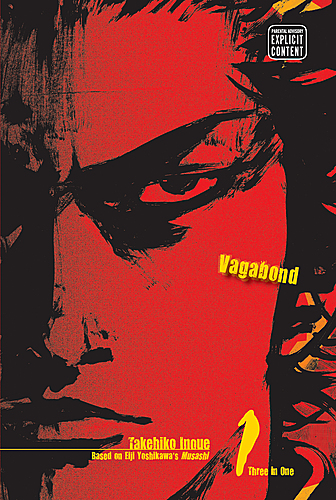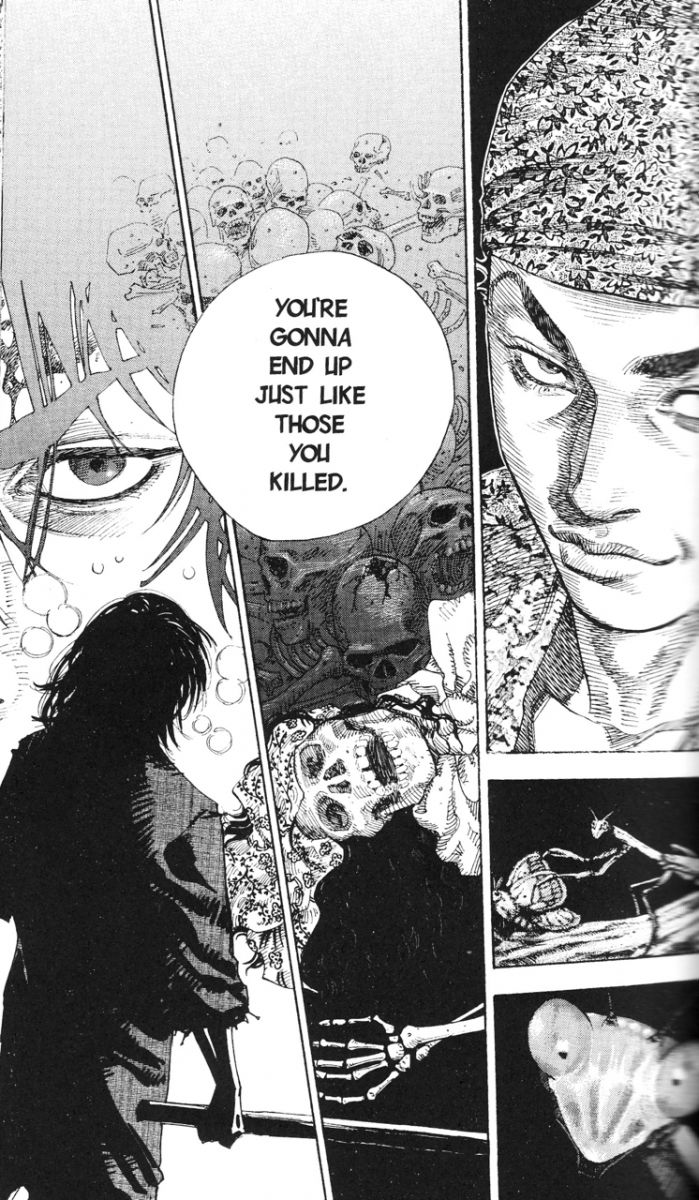As you may well have sussed, I've got it hot and heavy for alliteration. For that reason, I've singled out the month of March to highlight a few of the best and brightest manga titles from my ever-swaying stack. Each week I'll showcase a new Japanese comics title, be it popular or obscure, right-to-left or flip-flopped. These import digests have flooded into chain book retailers, often outnumbering the domestic fair. It isn't all nose-bleeds and sweat-drops though, and I promise you won't get slapped with any tentacles. So if you're up for something slightly different, join me in celebrating March Manganess!
 You want real bang for your buck, you gotta go big. VIZBIG.
You want real bang for your buck, you gotta go big. VIZBIG.
I know. I sound like a shill. But this format is a real value, packing three regular volumes into one huge honkin' paperback omnibus. And when you're trying to catch up on an ongoing series with around thirty volumes translated so far (so far!), you need all the help you can get.
This week, we're looking at Vagabond, a highly revered samurai saga that started back in 1998. Simply put, it's an embellished biography of Miyamoto Musashi, the warrior philosopher who literally wrote the book on bushido. If you've ever lunged over an ottoman to slash a hole in reality with a cardboard tube, you owe your savage fantasies to Musashi. This volume introduces him in his first incarnation, the young rapscallion Shinmen Takezō. It's also my first introduction to the legendary swordman's life story and to the work of writer/artist Takehiko Inoue.
Back in my days as a mod for an anime message board (shut up), my jams were Neon Genesis Evangelion and Rurouni Kenshin. The latter is what I'd call an arcade style samurai jaunt, a mostly lighthearted series about a peaceful former assassin forced time and time again to unleash his bad self to protect his loved ones. That series was originally a manga, and it, too, can be found in VIZBIG editions. I'm a total Kurosawa and Japanese cinema junkie, but Kenshin and the odd issue of Blade of the Immortal and Lone Wolf and Cub are the sum of my experience with samurai comics. Now I'm reading about the grandaddy of them all.
The first thing to note about Vagabond is its mythic sensibility. Musashi is something of a folk hero in Japanese culture, but I'm not sure whether he's more Wild Bill Hickok or John Henry. He was certainly a real person, but it's hard to say just how much of his many exploits are based on actual historical incidents or spun from oral tradition. The episodes recounted in this volume seem to be a little of each, starting in the aftermath of an actual battle between rival clans at Sekigahara in 1600. Young Shinmen Takezō (Musashi) and his childhood friend Hon'iden Matahachi barely survive the battle, and as remnants of the losing side, take to the woods for safety. They're taken in by two female thieves, a mother and daughter team who reap the battlefields for weapons and armor to sell as a way of life.
Here's where it starts to feel like fable.
Matahachi falls for the matriarch Oko, but she has her eye on the brooding Takezo. After a successful battle with a local band of brutes, Matahachi goes to Oko in the middle of the night, hoping to seal the deal. It's dark, and when he throws himself at her, she asks who he is. He lies, telling her he's Takezo. She accepts this and they go at it. It's the kind of nonsense that happens to Sinbad the Sailor or someone from the earlier pages of the Old Testament. It's crass and sort of insulting as a contemporary device, but I assume it's a traditional element of the Musashi story. I'd rather the author had taken a more realistic approach to the adaptation even if it meant resorting to total fabrication of incidental details. That doesn't mean this isn't a worthwhile read, because it certainly is. It's a traditional retelling, and seems like an authentic document of the Musashi story as it exists in the myth and legend of Japanese culture. We haven't stopped reading the original King Arthur stories simply because Marion Zimmer Bradley and others have added more modern interpretations in the centuries since.
 It really does feel as grand and lofty as a King Arthur story. Musashi spends a good portion of the book bound in rope and suspended from a tree. He has a lot of time to dangle and think as penance for being a brutal swordsman feared and reviled even by his own village. He eventually finds religion with the help of a lone monk, and the story gets a little more complex. This isn't just an action yarn about a violent and tortured samurai hacking a path through 17th century Japan. It's the story of a philosopher and teacher in the making. He's no Siddhārtha, but he does end up writing a pretty cool book on kenjutsu in The Book of Five Rings, the Japanese equivalent of the Chinese Art of War. Right this minute there's probably a martial artist reading it before her next practice, a Gordon Gekko type listening to the audio tape on his way to a martini lunch, and a soldier quoting it in his Facebook status. I'm excited to find out how the brash and ornery Takezo evolves into the warrior sage who inspires countless thinkers, fighters, and leaders centuries after his death. If that means wading through some parables, so be it.
It really does feel as grand and lofty as a King Arthur story. Musashi spends a good portion of the book bound in rope and suspended from a tree. He has a lot of time to dangle and think as penance for being a brutal swordsman feared and reviled even by his own village. He eventually finds religion with the help of a lone monk, and the story gets a little more complex. This isn't just an action yarn about a violent and tortured samurai hacking a path through 17th century Japan. It's the story of a philosopher and teacher in the making. He's no Siddhārtha, but he does end up writing a pretty cool book on kenjutsu in The Book of Five Rings, the Japanese equivalent of the Chinese Art of War. Right this minute there's probably a martial artist reading it before her next practice, a Gordon Gekko type listening to the audio tape on his way to a martini lunch, and a soldier quoting it in his Facebook status. I'm excited to find out how the brash and ornery Takezo evolves into the warrior sage who inspires countless thinkers, fighters, and leaders centuries after his death. If that means wading through some parables, so be it.
I'm mixed in my reaction to the art, at least at this early stage in the series. While there are many stunning splashes throughout, this isn't my favorite manga art style. Many of Inoue's faces are presented head-on, with little definition. This makes the characters appear flat. I'm always conscious that they're drawings of people and not people themselves. You see this a lot with early artwork, or even early filmmaking. It's that classic joke about high school stage and film productions, where everyone is backed against a wall, staring directly at the audience, all two-dimensional and formless. This certainly isn't true of every page, but with the presence of several Vagabond art books out in the wild, I have to imagine that this collection isn't the best showcase of the series' visual flare. It should also be noted that this edition contains several color sequences, usually at the head of new chapters. Similar to the red sequences in PLUTO, they use a technique that looks much different than the coloring you normally find in western comics. Here, they tend to color around the lines, almost as if they're inking with bold hues. The contours of muscle are vibrant peach, with a lighter coloring inside the form. I prefer the starkness of the black and white pages, but the color sections are always a welcome change of pace.
If you're familiar with the other samurai books I mentioned like Rurouni Kenshin and Blade of the Immortal, this series exists somewhere in between. While not as comical or pretty Kenshin, it's also not as gory or sinister as Blade of the Immortal. The draw here is that ongoing history lesson and an emerging subtext of philosophy. It's about a wild child who ultimately becomes a leader of men. And in doing so, sparks a religion of combat, strategy, and craft. And if you like that arcade style samurai action, that's here too. The guy loves a duel. You can hear the metal on metal, the bare feet against the clay, the cicadas in the trees. And there's just a whiff of sandalwood and type A-.
Paul Montgomery is both a lover and a fighter. Find him on Twitter or contact him at paul@ifanboy.com.


loving the rurouni kenshin reflection, p-money!
this sounds interesting… definitely checking this out after PLUTO
Vagabond is a great read and the VizBig editions are gorgeous!
It’s funny you’re writing about a samurai manga, as I’ve really been in a feudal Japan mood for the past few days. I just finished watching Sanjuro, and am about to watch this cool anime called Basilisk (which I think is also a manga). Plus, I’ve been listening to GZA’s Liquid Swords, which has clips from Shogun Assasin seeded through it.
I always like the stories of the wise and skilled warrior traveling the land, getting into various adventures and imparting thier wisdom along the way. This does in fact remind me of a few Kurosawa films, and Zatoichi as well. I’m definitely getting this.
CHAMBARA!
VizBig editions are awesome!! You get way more comics, 500 pages for like $5. American Comics never have deals that good.
Vagabond is a great read. There was a show on the History Channel a couple days ago that was about Musashi Miyamoto. Now I gotta go get the 6th vizbig
I must say Paul, I’m happy that you’re showing the breadth of manga in this series. I was hoping you would showcase this series as it’s one of my favorites.
The series doesn’t just draw from historical fact and rumor, but is also heavily influenced by the Eiji Yoshikawa’s novel "Musahsi." Around volume 16 is where Inoue diverges from the novel, which many people consider to be cannon when discussing Musashi. (The English version is available on Amazon.)
I understand what you mean about the head-on drawings for the faces, but I thing his inking is amazing throughout the book, especially the clothing. I also like the depiction of the sword fighting how it’s not some swashbuckling, outrageous lightsaber duel, but sometimes the most important part of a sword fight is to not doing anything at all.
I just saw and exhibition of Inoue’s work a couple of week ago, and his watercolors are amazing.
Thanks again, Paul, for another great manga article. It’s fun to see how your tastes overlap with mine. Although, I was never an anime message board mod. 🙂
Dude, Paul, you ROCK!!! These "March Manganess" articles have all been AWESOME and what’s more, your choice in literature has been totally BRILLIANT. I hope a ton of readers pick look into these titles and perhaps even manga in general thanks to your work here.
Thank you for sharing this, and I gotta say, I would not mind in the least if you gave us "APRIL MANGANESS" and "MAY MANGANESS" and "JUNE MANGANESS" and so on and so forth… 😀